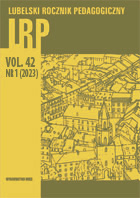SŁOWA TWORZĄCE OBRAZ WSPÓŁCZESNEGO ŚWIATA DZIECI NA PODSTAWIE BADAŃ TECHNIKĄ ABECADŁA STEFANA BALEYA
WORDS FORMING CHILDREN’S IMAGE OF CONTEMPORARY WORLD: A CASE STUDY OF RESEARCH USING STEFAN BALEY’S ALPHABET METHOD
Author(s): Kinga KuszakSubject(s): Preschool education, Sociology of Education, Pedagogy
Published by: Wydawnictwo Naukowe Uniwersytetu Marii Curie-Sklodowskiej
Keywords: linguistic image of the world; research on linguistic image of the world changes in linguistic image of the world; research using Stefan Baley’s alphabet method;
Summary/Abstract: Introduction: The article presents a linguistic image of the modern world based on a study on children performed using Stefan Baley’s method. The article follows up with a discussion of the theses of the author’s own research. The article presents selected research results.Research Aim: The research aims to understand better children’s and youth’s experiences using the abecadło method and to compare results with those published in 1947 by Stefan Baley’s research team.Method: The research was proceeded by the abecadło method suggested by Stefan Baley and used by his research team in 1945 and 1947.Results: The presented results respond to three elements: words-associations most commonly recalled by children (taking differences between younger and older groups into consideration); words-associations reflecting ongoing social-cultural changes (taking differences between younger and older groups into consideration); words considered as universal and independent from the political, cultural, social and economic context and separated from the age of resear- ched groups.Conclusion: The research show that present-day children’s experiences can be grouped and presented as four types of associations: 1) the first one is created by mass media and modern technology; 2) the second one is created by geographic names and connected with nature ones: animals, plants etc.; 3) the third one is created by words related to human and animal proper nouns; 4) the fourth one is created by universal words.
Journal: Lubelski Rocznik Pedagogiczny
- Issue Year: 42/2023
- Issue No: 1
- Page Range: 65-77
- Page Count: 13
- Language: Polish

